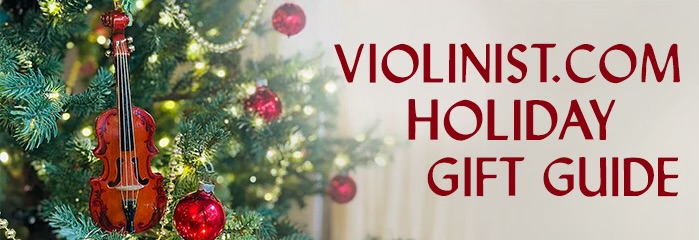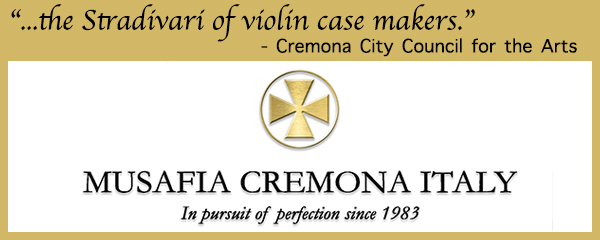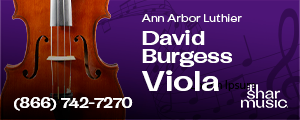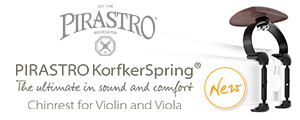microphones for quartet...
Techie question.I want to start recording our quartet sessions. I have a nice Mac Pro and an interface and plan to use Bandlab for a 2 channel setup. My question regards the best microphones. I'm inclined to get a pair of condensers -but wondered if I should use a microphone with a different frequency sensitivity range for the violins vs the viola and cello.
Price for the two up to (say) $600. Specific suggestions very welcome.
Tweet
Replies (83)
I am not a pro engineer but for what it's worth, I continue to be surprised with the quality of my super-cheapo Lyx Pro stereo pair.
p.s. Didn't you post about getting Hifiman headphones a few years ago? I heard these a while later and ended up with a pair, still very satisfied with how they sound. (Build quality could be better.) Way better sounding than my old Sony cans, and also a good example of how folks can spend way more money than this for diminishing returns.
p.s. Along the lines of simple, my current favorite setup for string quartet is a single, active, stereo AEA R88a ribbon mic...active so that you don't have to fuss with additional pre-amps, stereo so you don't have to mess with positioning individual mics. Google AEA OneMic series and John Cuniberti for videos of what can be done with this.
The response in critical frequencies is flatter than other mics in similar price range. Especially the omni capsule.
If you just want a recording, you can use your phone. A step up is an all in one recorder, such as the zoom series. However, when you want a still higher level and more control over things like microphone placement, then individual mics such as the ones I mentioned above are needed.
A professional microphone such as the Royer sf24, or schoeps cmc6 with mk4 capsule can run several thousand dollars. So you have an idea of price range.
When I say condensers can sound harsh, it is not as if they are worse than the mic on your phone. In general condensers are very detailed. It is their level of detail and quick response that can be tiring or harsh. Most professional orchestras record with condensers, as do some violin soloists.
Ribbon mics handle violins very well. The Coles 4038 was a favorite of some soloists. RBP has recorded on a Royer sf24.
Microphones are delicate. Ribbon microphones are especially so, as they contain a thin foil strip that can be damaged by wind. When I mentioned a safe environment for a ribbon, I mean one that is indoors, and does not have animals that may knock over the stand.
I think you would be very happy with the oktava or line audio mics. However, if you have the funds you may want to consider a ribbon mic.
Golden age projects r1 mics are good inexpensive ribbon mics. There are others such as the cascade fatheads. A pair with a preamp such as the cloudlifter should be less than 600.
So you can have a ribbon setup at that price. There is more of a risk that the mics are not to spec or matched.
Audio interace: Scarlett, Presonus, or Audient (~$129)
Condensers: Audio Technica AT 2020 ($99 each)
Cables: Monoprice XLR
Stands: Any
Of course, this requires a computer to run the DAW (digital audio workstation) software. Bandlab online works, as well as their free release of CakeWalk (based on SONAR Platinum), as does Apple's GarageBand, or any one of the other free options. I grew up on ProTools, and they have a free version limited to 8-tracks (ProTools Intro), but nowadays I use Reaper or Logic Pro for most things.
Sure, my colleague with his collection of multiple matched sets of Coles 4038, Neumanns, and whatnot would laugh, but a single one of his heavy duty wheeled microphone stands is $500+. Just for one mic stand! He lives and works in a completely different universe than most of us for audio...
Real portability is also super nice, vs. dragging your laptop and audio interface around and an extension cord, cabling, etc. etc.
EDIT: I mounted the recorder on a 5th music stand (without the desk) in the middle of the quartet, which was sitting in the same circular positions we had used in all rehearsals.
The recorded sound seemed excellent to me. I had played cello for that quartet group.
Have fun!
Bart
Gordon, the difference between large diaphragm and small diaphragm microphones when it comes to low frequencies is not really a matter of what they can record (they both will capture pretty much everything in one way or another) but how the actual diaphragm will respond to different frequencies. You could technically capture a bass or a kick drum with a pencil, but only a large diaphragm will get that voluminous THUMP. Imagine putting a C string on a violin versus a 20" viola.
There are large diaphragm condensers that are well suited to recording strings. Their response at the high end is fine. The legendary Neumann U87 has been used on many classical recordings.
Dynamic mics are not only for live music. They typically do not have as hot a signal, but are perfectly usable.
Overall though, I think there is agreement in all the responses. Small diaphragm condensers, or ribbon mics are the types to consider.
The ribbon mics will likely be more expensive and require greater care. However, many engineers and soloists prefer ribbons.
Speaking of recording in proximity, the absolute best sound i got (over vintage Neumann and ribbons) was with an Electrovoice RE-20 (which is a large dynamic). Second was a SM-57.....
The Rode NT-4 stereo microphone. It runs off phantom power provided by your preamp, or on battery power for use with a portable recorder (such as the Zoom recorder mentioned above). Nice and simple!
And a very nice sound for the price! It can often be found used in the US$ 300-400 range.
Here is a video documenting the NT-4's sound when recording violin at various distances, and it also describes how to interface it to a Zoom recorder.
https://youtu.be/Vynl0AXPqiw
I use this mic for recording small groups on location with the Zoom recorder and it's a very low stress setup compared to lugging a laptop, interface, etc.
Edit to add to all this talk earlier about ribbon mics - if you don't get active mics with built-in preamps, you will need to buy in-line preamps separately. And with built-in preamps, the manufacturer has already matched the preamp to the microphone, so one less thing for you to worry about.
I've long advocated ribbon microphones. This discussion has come up before and I did a microphone comparison so that comparison can be more objective:
https://soundcloud.com/mrchristopherpayne/microphone-tests-on-violin
My favorite, for both price and function, is the Burd Igor ribbon microphone which is handmade in Russia (clone of Royer R121) and was a steal at about $150, but I fear Putin may have changed the way we do business with Russia and I don't know if they are still available. I did get an MXL R40 on sale and I'm impressed with it as a budget microphone ribbon microphone. I paid about $80 but they go full price for around $160 [I have no experience with the 144 but see it go for about $100].
It's kind of annoying how studios get the idea that condensers are the way to go. If you want a sharp sound then I guess it is!
If your budget allows, then Royer 121!
The Royer 121 is one of the 'new generation' of more detailed ribbon mics. Other such mics include the superb Mesanovic model 2, and thr aea n8.
The very inexpensive ribbons, such as the mxl can be fine. However, they also may not be. It is a matter of quality control, handling, and warranty.
I can get my hands on a AKG C414 - which is I think, a high-end dynamic condenser microphone. How does that compare to the ribbon mics for the violin? From Mark's comments, I guess I need at least one more longer-range microphones.
However, it seems that eventually I'll look for a good ribbon microphone, especially for solo recordings.
I've never liked the 414s (new and vintage) for solo violin. As an ambience mic, i would not know......
I don't mind condensers for lower strings. Condensers are very good for detail but for high strings that translates as harsh. Ribbons have detail too but the color is different.
When it comes to finding recommendation for microphones from Youtube etc., you have to understand the mind of the studio engineer: "Violin high - need treble! Take out mud!! Condensers work on instruments - violin is an instrument!!" Understand that studio engineers are looking for punch in everything else they record - voice, drums, guitar, bass. They are also concerned about the rich, warm end of strings that can interfere with vocals and want to cut those mid frequencies. That's fine when there are vocals but they will do it if it's just strings being recorded too, and it is a fine line to tread between warmth and muddiness. "Mud" frequencies are between 200-500hz. That's the G string on a violin to B on the A string. Cut those too much and it ain't pretty! One trick is to boost the frequencies after the ones you have cut. It's a lot of experimentation but it all comes down to the mix and the sound you want.
It is well out of your budget. In its price range there are other contenders. This being said, yes the 414 would be on the short list.
Yes, you need two mics to record in stereo. The 414 is a multi pattern microphone. It can be used in omni directional mode to record sounds equally from all directions. Thus you could use a single mic to record the group in mono.
You certainly do not need to get a ribbon. There are many wonderful condenser mics even for violin. However, most such mics are more expensive than your 600 budget.
James Ehnes bought Telefunken m60s for his home concerts during covid. They are condenser mics.
Learning what mics are used on recordings can give you some idea of what they can do.
So it is great that you have the 414. However, if you like it, you would be in an awkward position. You could buy another 414, and hope they match well. You could also sell the 414 and then buy a matched pair of 414s.
And its fun!
The resulting recording will be pretty much ready to go and should sound good to internet listeners without much editing.
The alternative path, since you do have 4 preamp channels available with the M6, would be to mic each instrument separately and then mix them down to stereo using a digital audio workstation (DAW). The amount of effort involved in getting a final product with this approach could easily be 10x the first method. However if you are willing to research and learn good mic placement techniques, equalization, and all the twiddly bits required to use a DAW, it can result in a very enjoyable output that captures nuances of each instrument in a way that may be difficult with a stereo recording. Your microphone outlay for 3 more mics could be kept under budget if you shop carefully (considering the used market), with the 414 as your ‘flagship’ mic. Mic placement will play as big a role as mic quality in the sound you get.
Good luck!
Jon - I think you get the level I am aiming at - your plan B. My current thought was to use the 414 for the cello-viola and a better (but complimentary) mike for the two violins. However, Marc and others have talked about matched mikes - which is at best I guess two of the same kind that have actually been tuned to be near-identical. Is this important? What happens if you use different mikes as an in my plan? Does it not mix well anymore?
If two different types of mics are used it would create an unusual stereo field.
With software you can assign different levels of the signal from different mics to the right and left track.
This being said, you will want to capture a bit of the room as well. I do not recommend having a mic for each instrument and placing them close to each. Overkill, and you will not get as much of the room.
A matched stereo pair will get good results.
Start with a mono recording with the 414. See how you like it.
If you instead choose a different mic as your second mic (admittedly more in your budget) and point them both towards the pairs if instruments as you propose, you will not be able to create a good stereo image even if you use ORTF spacing, as the mic qualities will differ sufficiently that your ears will not be fooled. Your best bet there would be a mono mix or lightly panned left and right. But I see that as less satisfying for the listener.
There is still that plan A option of a good quality stereo pair or a built-in stereo microphone (or even a Zoom stereo recorder) which, in an acoustically pleasing space, will give you s very satisfying recording with considerably less muss and fuss…
These are all ultimate solutions. I'm sure you can get a good result with what you have given the scope of the project.
My suspicion is that by mixing signals from a number of different recording locations one confuses the phase (timing) information that is an important factor in recreating the sound stage. Over the past 50 years recording companies have periodically gone through phases (sorry) of overcomplication, sometimes favouring a very close-up acoustic in which each individual instrument is sharply spotlit. The opposite tendency also occurs, where engineers seem to favour a more distant and blended sound which at worst might be described as "mushy". Listening to some of the classic recordings from the 1950's and 60's you may wonder if any important advances have been made since then.
Of course, a 4-mic strategy (possibly augmented with a stereo overhead) would be the most flexible and could be mixed with spatial separation among instruments.
For a first time user, setting up a stereo array is simply much easier.
And of course the easiest place to begin is with a mono recording. She can experiment with mic placement, etc.
I see that my main concern seem to not be that of the group - that is the faithful input of each instrument according to its dynamic range (which is why I thought of the two different microphones - and yes, a mixed mono output.
As Mark said, I think the best strategy now is to go ahead with the mono since I have a good starting condenser microphone (414), and see how that contrasts with the cell phone. Since all the social media outputs (FB, Soundcloud, youtube etc) only input mono anyway I'm not sure I have a need for a stereo recording. We'll add that when we become competitive for Banff (LOL!).
However, I will put the ribbon mike on the wish-list - in particular for playing solos and with piano. I listened to some examples and, yes, the recordings were stunning, even from youtube.
Again, thanks for all the input. More anon....
[Steve wrote "Listening to some of the classic recordings from the 1950's and 60's you may wonder if any important advances have been made since then." Yes, what is that about? Some of those are marvelous - but maybe that should be a separate topic....]
Paul's suggestion of going to an engineer and auditioning mics is a very good one. They work odd hours so it should be possible to schedule time. Large stores may also let you audition mics. Academic institutions may also be able to accommodate you as well.
You can explain your situation and request that they use your interface, or affordable equipment. Hearing a mic through a grace preamp is much different than an inexpensive one.
Be sure to explain your use case. That way they will record you from an appropriate distance, as opposed to close micing the violin. Although you may want to hear the close micing as well, to consider that sort of set up.
Not Micking I guess, that would rhyme with ticking but 'miking' is legit is that preferred?? English is enough of a nightmare as it is! :) Maybe it should not be 'mic' at all but 'mike'.
OK, English pedant will go practice...]
In terms of the shotgun closet, one of the best things I did for my mics was to get a Pelican case for two of my mic pairs, but it makes it look like I am carrying around a pistol.
https://www.youtube.com/watch?v=b3b06wrOwAI
However, if that were the only difference one would have thought it possible to make the two similiar with a post-recording high-frequency cut off...
If anyone knows of a better DAW for classical music (and not insanely difficult) please let me know!
Just record mono with the 414 at a distance of 6 feet or so with the mic six feet in the air.
See how it sounds.
It is much better play the dynamics than to try to post process them.
I think I'm falling down a rabbit hole!
Microphone interface working, MIDI keyboard plugged in... waiting for Apple to let me download the DAW - I can always start with Garageband and upgrade to Logicpro.
[Note, this stuff does not scare me - I did world-class electrophysiology for 30 years so lost any fear of wires and data software ;) ]
You are now talking about new things, creat8ng accompaniments. One option is to record an acoustic performance of the accompaniment. This is what I would recommend, as the other options will sound not quite acoustic at best. Another option is to use a program to generate the accompaniment. A midi file cam be used as a start. DAWs are not necessarily the best programs in this regard. Most are designed to work with audio, as opposed to having tons of tools and interfaces to handle non acoustic music.
The daw that is best suited to non audio is probably ableton live. However there are lots of other non daw options.
However, again, I would recommend that you make a recording of an acoustic performance of the accompaniment.
But if you don't use a DAW to record what do you use? I did sort of think that that was essential if you have multiple mikes - if just to adjust the volumes for mixing....
Rosegarden is a free sequencer, that let's you record and edit midi. It is kind of like a word processor. Cubase was originally a sequencer.
Different daws have different strengths with regard to these components, such as sequencers.
Many notation programs also have some features to create audio or midi output. These features are usually not as robust as the Midi sequencers.
There are just so many types of software out there, from virtual instruments, to audio processing software such as izotope.
There are also programming languages, such as max.
Experiment and see what works for you. Most paid software has free or inexpensive trials.
It all depends on how far afield you want to go from audio recording.
Audacity is a fine free program for audio recording, as Steve noted.
How are you finding it for audio editing? Effective? Well designed?
https://www.apple.com/us-edu/shop/product/BMGE2Z/A/pro-apps-bundle-for-education
Have to reactivate my university account, should not be a problem. Thanks for the tip! And also on the video syncing - that's down the line. I'm going to play with creating my own accompaniments for fun and see where that goes.
This discussion has been archived and is no longer accepting responses.
Violinist.com is made possible by...
International Violin Competition of Indianapolis
Violinist.com Holiday Gift Guide
Dimitri Musafia, Master Maker of Violin and Viola Cases
Johnson String Instrument/Carriage House Violins
Subscribe
Laurie's Books
Discover the best of Violinist.com in these collections of editor Laurie Niles' exclusive interviews.

Violinist.com Interviews Volume 1, with introduction by Hilary Hahn

Violinist.com Interviews Volume 2, with introduction by Rachel Barton Pine


















You will have a stereo pair that captures everything, instruments, hall, etc.
In many instances people use condensers in xy or ortf configurations.
Oktava mk12 are well regarded budget mics. Line Audio cm4 are also very good.
Howewver, condensers on strings can be harsh.
You may want to consider ribbon mics if the environment is safe. Mid side.
600 is on the low side for the ribbons. A favorite is the beyerdynamic m160 paired with a traditional figure 8 ribbon. The 160 alone is more than yoir budget.